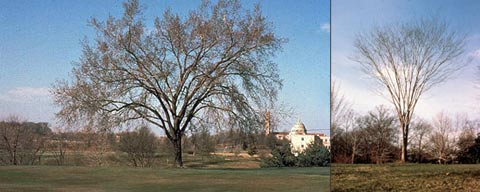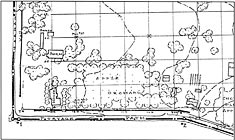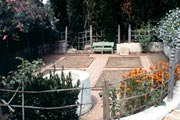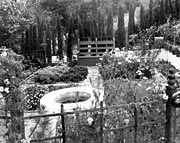

Guidelines for Restoring Cultural Landscapes
Vegetation

Identify, Retain, and Preserve Historic Features and Materials from the Restoration Period
![]()
Identifying, retaining and preserving the existing vegetation from the restoration period prior to project work. For example, woodlands, forests, trees, shrubs, crops, meadows, planting beds, vines and ground cover.
Documenting broad cover types, genus, species, caliper, and/or size as well as color, scale, form and texture.
Evaluating the condition and determining the age of vegetation from the restoration period. For example, tree coring to determine age.
Retaining and perpetuating vegetation from the restoration period through propagation, using methods such as seed collection and genetic stock cuttings.
![]()
Undertaking project work that impacts vegetation from the restoration period without executing an “existing conditions” survey of plant material. For example, deep-tilling soil thus disturbing historic pollen artifacts.
Undertaking work without understanding the significance of vegetation from the restoration period. For example, removing perennial plantings from the restoration period during a clean out of invasive vegetation.
Failing to propagate extant vegetation from the restoration period, when few or no known sources for replacement are available. For example, removing a deteriorating tree without first taking cuttings.
Protect and Maintain Features and Materials from the Restoration Period
![]()
Protecting and maintaining vegetation from the restoration period by use of non-destructive methods and daily, seasonal and cyclical tasks. For example, employing pruning or careful use of herbicides on historic fruit trees.
Utilizing maintenance practices which respect habit, form, color, texture, bloom, fruit, fragrance, scale and context.
Utilizing historic horticultural and agricultural maintenance practices when those techniques are critical to maintaining the integrity of the vegetation from the restoration period. For example, the manual removal of dead flowers to ensure continuous bloom.
![]()
Failing to undertake preventive maintenance of vegetation from the restoration period.
Utilizing maintenance practices and techniques which are harmful to vegetation from the restoration period. For example, mowing lawns containing spring bulbs.
Utilizing maintenance practices and techniques that fail to recognize the uniqueness of individual plant materials. For example, utilizing soil amendments which may alter flower color or poorly-timed pruning and/or application of insecticide which may alter fruit production.
Employing contemporary practices when traditional or historic can be used. For example, utilizing non-traditional harvesting practices when traditional practices are still feasible.
Repair Features and Materials from the Restoration Period
![]()
Rejuvenating historic vegetation from the restoration period. For example, by corrective pruning, deep root fertilizing, aerating soil, renewing seasonal plantings and/or grafting onto historic genetic stock.
![]()
Replacing or destroying vegetation from the restoration period when rejuvenation is possible. For example, removing a matured shrub and replacing with new material when proper pruning may be employed.

When replacing deteriorated or declining vegetation and the same kind of material is not available, then a substitute material may be considered. This material should be of compatible scale, color, form, shape and texture. Considering a mature American elm’s pendulous form [left], a Japanese zelkova’s vase-like form [right], such a substitution of plant materials would not meet the Standards. (NPS, 1994)
Replace Extensively Deteriorated Features from the Restoration Period
![]()
Using existing physical evidence of form, habit or composition to replace a deteriorated or declining vegetation feature from the restoration period. If using the same kind of material is not technically, economically, or environmentally feasible, then a compatible substitute material may be considered. For example, replacing a memorial tree with a tree grown from its genetic stock.
![]()
Removing vegetation from the restoration period that has deteriorated and not replacing it, or replacing it with a new feature that does not convey the same visual appearance. For example, removing a blight-ridden hedge and replacing it with pyramidal form trees.
Remove Existing Features from Other Historic Periods
![]()
Removing or altering vegetation from other historic periods. For example, removing later foundation plantings or successional woodlot growth.
Documenting vegetation from other periods prior to its alteration or removal. If possible, representative examples of this vegetation should be saved, cultivated and managed, through seed collection and genetic stock cuttings, to facilitate future research
![]()
Failing to remove vegetation from another period, thus confusing the depiction of the landscape during the restoration period. For example, maintaining a lawn on the site of a historic cutting garden.
Failing to document vegetation from other historic periods that is removed or altered so that a valuable portion of the historic record is lost.


The Estate Drive through the Apple Orchard at Stan Hywet Hall , Akron, Ohio, is being restored to a 1913 design by Warren Manning. Based on historic documentation [top] those trees that were inappropriate to the original design were removed [bottom]. (Douglas Reed)
Re-Create Missing Features from the Restoration Period
![]()
Recreating a missing vegetation feature that existed during the restoration period based on historical, pictorial and physical documentation. For example, replanting crop types based on pollen analysis.
![]()
Installing vegetation that was thought to have existed during the restoration period, but for which there is insufficient documentation; or planting vegetation that was part of the original design but was never installed, thus creating a false historic appearance.
As part of an overall restoration program for each of the gardens at Rancho Los Alamitos in Long Beach, California, close attention has been paid to its vegetation features. [top] The Rose Garden has been restored including replacing in-kind the original rose trees (only one survived) using the original 1927 plan by the Olmsted Brothers. The Cutting Garden has also been restored, [below] which until recently had been maintained as a herb garden. A recent discovery of these plans allowed for the restoration of the garden including its herbaceous materials and even the design of the garden bench. (Rancho Los Alamitos Foundation)

